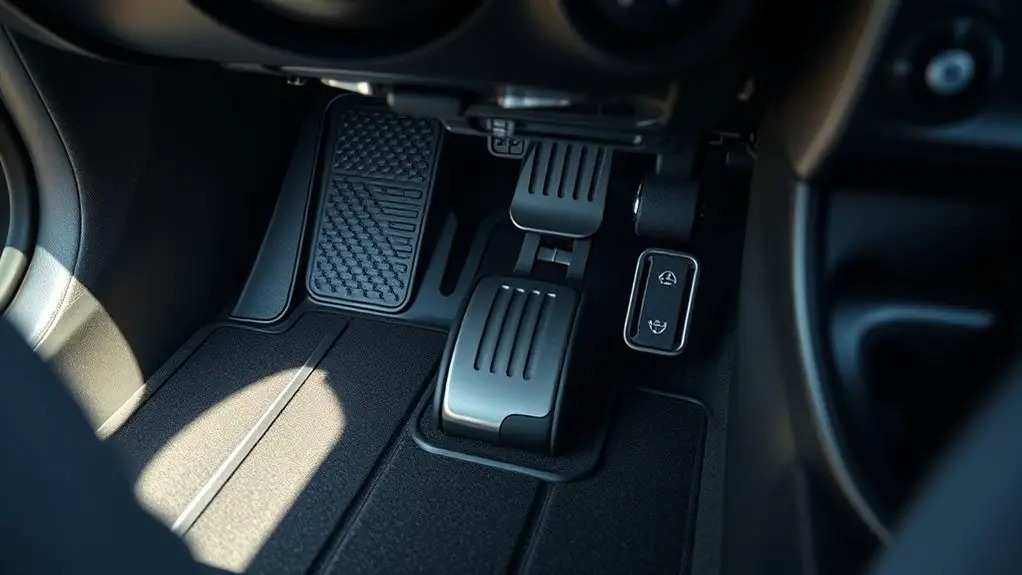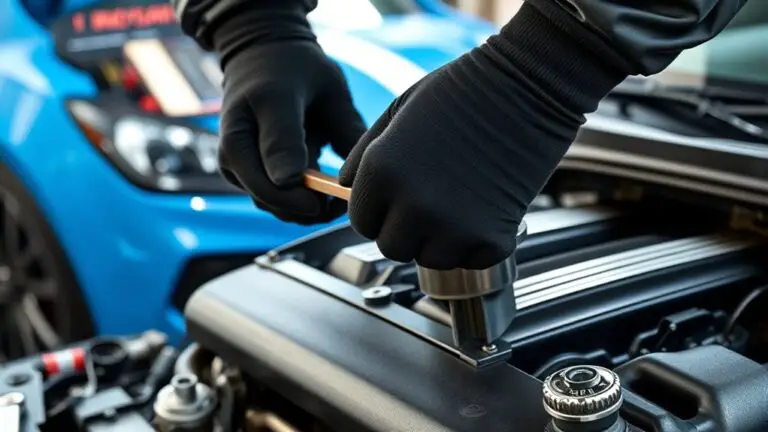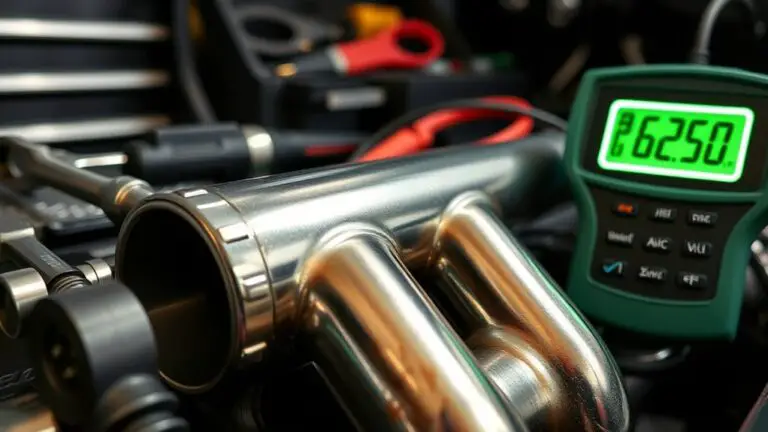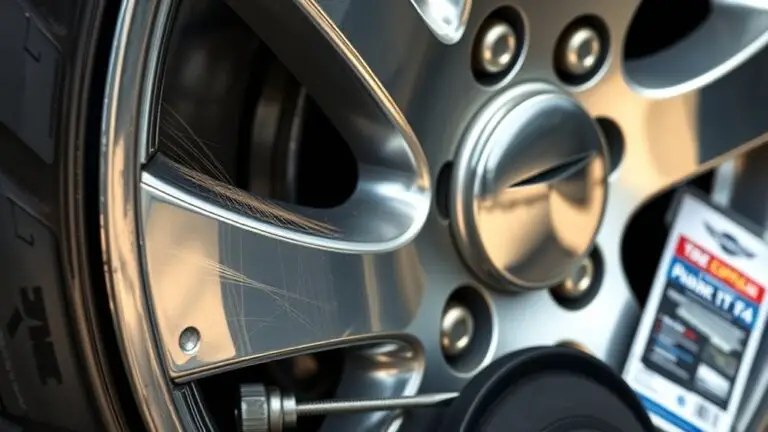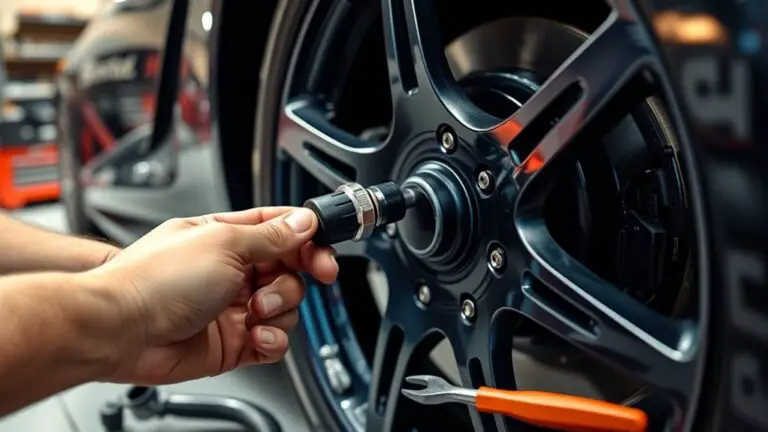How to Diagnose Brake Pedal Sinking in Compact Car
To diagnose a sinking brake pedal in your compact car, start by checking brake fluid levels and looking for leaks around the reservoir. Inspect brake lines and hoses for cracks or damage. Next, assess the master cylinder and evaluate the brake pads and rotors for wear and uneven patterns. If you suspect air in the lines, bleed the brakes. If problems persist or you’re unsure, seeking professional help is essential for maintaining safe braking performance. Exploring further will provide additional solutions.
Understanding the Brake System in Your Compact Car
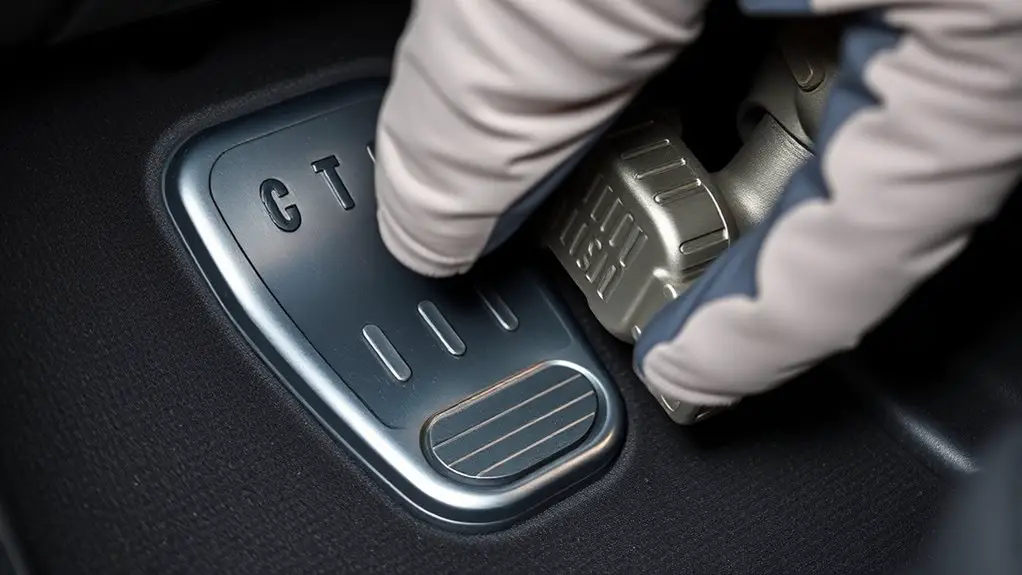
The brake system in your compact car is a critical component that guarantees safe stopping power. Understanding its key brake system components is essential for maintaining your vehicle’s performance. The system primarily operates through hydraulic pressure, which transfers force from the brake pedal to the brake calipers. When you press the pedal, hydraulic fluid moves through the lines, activating the calipers to clamp down on the brake rotors.
Key components include the master cylinder, brake lines, calipers, and rotors. The master cylinder converts your foot’s pressure into hydraulic pressure, while the brake lines deliver this pressure to the calipers. If any of these components fail or degrade, it can compromise your stopping ability. Regular inspections and maintenance of these parts will help guarantee your compact car delivers the freedom and control you need on the road. Keep an eye on your brake system to enjoy a safe driving experience.
Common Symptoms of a Sinking Brake Pedal
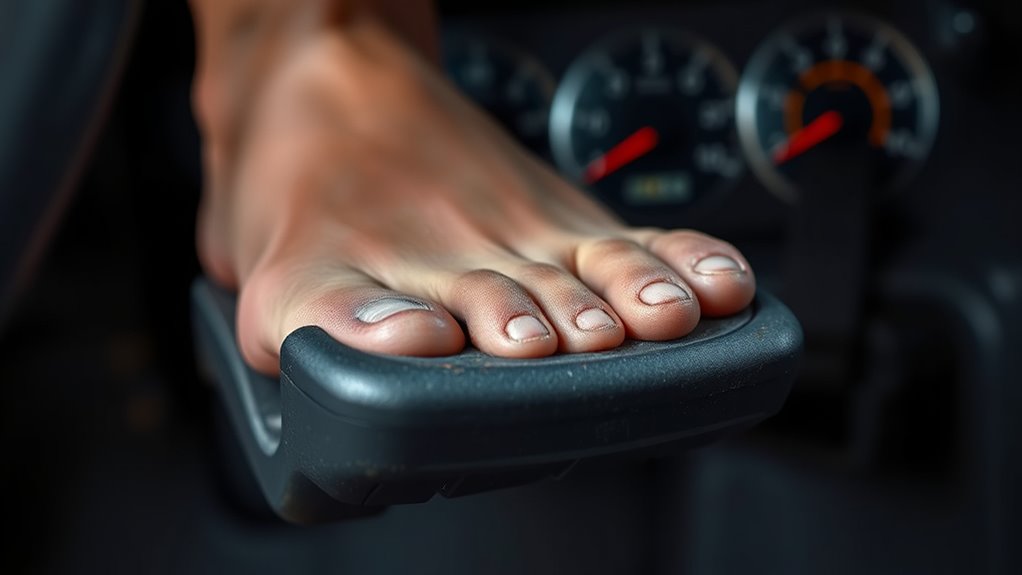
When your brake pedal starts sinking, you’ll notice several key symptoms. You might experience reduced brake responsiveness, unusual pedal travel, or even warning lights activating on your dashboard. Recognizing these signs early can help you address the issue before it escalates.
Reduced Brake Responsiveness
If you notice that your brake pedal feels soft or sinks further than normal when pressed, you might be experiencing reduced brake responsiveness. This issue can greatly impact your vehicle’s safety and performance. To assess the situation, consider these common symptoms:
- Longer stopping distances – Your car takes more time to halt.
- Increased pedal travel – You need to press the pedal down further.
- Weak brake performance – There’s a noticeable lack of stopping power.
- Unusual pedal feel – The brake pedal feels spongy or inconsistent.
Conducting a pedal feel analysis is essential to understand the brake performance factors affecting your vehicle. Don’t ignore these signs; addressing them promptly guarantees your driving freedom remains intact.
Unusual Pedal Travel
Unusual pedal travel can be a clear indicator of a sinking brake pedal, often signaling underlying issues within your braking system. When you notice that the brake feel isn’t what it used to be, and the pedal engages lower than normal, it’s imperative to investigate further. This altered travel may stem from air in the brake lines, fluid leaks, or worn components, each affecting how the pedal interacts with the braking mechanism. If your pedal feels spongy or lacks resistance, it could compromise your ability to stop effectively. Don’t ignore these symptoms, as they can lead to more significant safety concerns. Prioritize checking your brake system to guarantee peak performance and freedom on the road.
Warning Light Activation
One key indicator of a sinking brake pedal is the activation of warning lights on your dashboard. These lights serve as essential brake system alerts, signifying potential issues that require immediate attention. Ignoring these signals can compromise your driving freedom and safety. Here are four warning lights you should never overlook:
- Brake Warning Light – Indicates a general issue with the brake system.
- ABS Warning Light – Signals a problem with the anti-lock braking system.
- Fluid Level Warning – Shows low brake fluid, which can lead to pedal sinking.
- Traction Control Light – May illuminate if braking performance is compromised.
Understanding warning light significance can help you address issues before they escalate, ensuring your vehicle remains safe and responsive.
Potential Causes of Brake Pedal Sinking
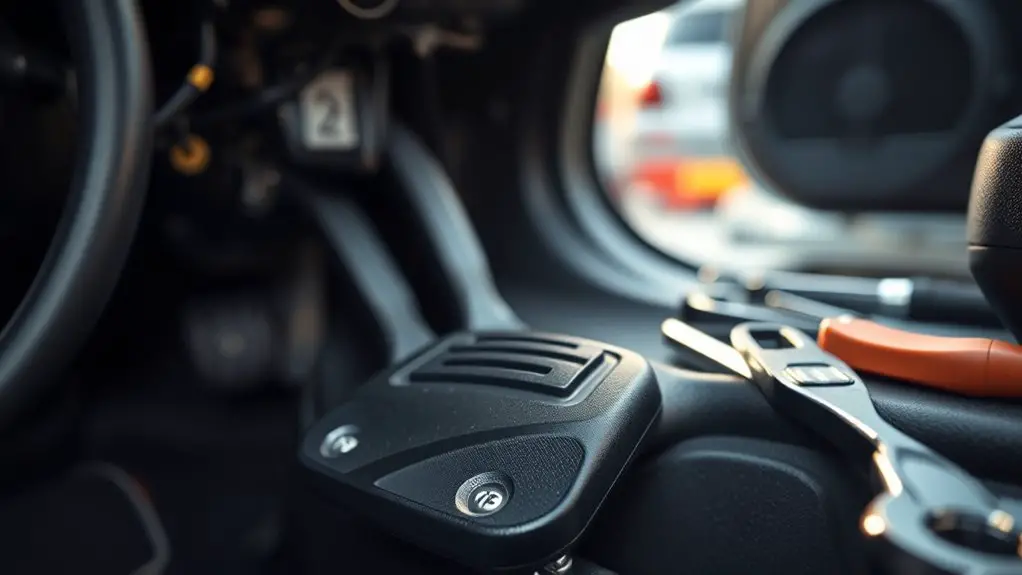
When you notice your brake pedal sinking, it often indicates underlying issues that require immediate attention. Common causes include air in the brake lines, worn brake pads, or brake fluid leaks. Each of these can lead to pressure issues, compromising your vehicle’s braking ability. Here’s a concise breakdown of potential causes:
| Cause | Description | Impact on Brake Performance |
|---|---|---|
| Air in Brake Lines | Trapped air reduces hydraulic efficiency | Causes sponginess in pedal feel |
| Worn Brake Pads | Insufficient friction material | Leads to longer stopping distances |
| Brake Fluid Leak | Decreased fluid levels | Causes loss of pressure |
| Master Cylinder Failure | Internal seals wear out | Results in brake fluid bypass |
| Contaminated Brake Fluid | Impurities affect fluid properties | Reduces braking efficiency |
Addressing these issues promptly can prevent more significant problems and guarantee your safety on the road.
Checking Brake Fluid Levels
It’s crucial to regularly check your brake fluid levels to guarantee peak braking performance. Low brake fluid can lead to a sinking brake pedal, compromising your safety. Here are the key steps for checking your brake fluid:
- Locate the Reservoir: Find the brake fluid reservoir, usually near the back of the engine bay.
- Inspect Fluid Levels: Verify the fluid is between the “min” and “max” marks. If it’s low, top it off with the appropriate brake fluid type.
- Check for Contamination: Look for discoloration or debris in the fluid. Contaminated fluid may require a full flush.
- Monitor for Leaks: Regularly check for signs of leaks around the reservoir and master cylinder, as this impacts brake fluid maintenance.
Maintaining the right levels and quality of brake fluid is essential for peak braking performance and vehicle safety.
Inspecting Brake Lines and Hoses
After ensuring your brake fluid levels are adequate, the next step is to inspect the brake lines and hoses. A thorough brake line inspection can reveal leaks or damage that may cause the pedal to sink. Check for any signs of wear, corrosion, or fluid seepage.
| Inspection Aspect | What to Look For |
|---|---|
| Brake Lines | Cracks, rust, or bulges |
| Hoses | Cracks, abrasions, or leaks |
| Connections | Secure fittings and clamps |
| Overall Condition | Check for softness or sponginess |
Make sure the hose condition is sound, as deteriorated hoses can lead to pressure loss in the braking system. If you notice any issues, it’s essential to replace the affected lines or hoses promptly to maintain your vehicle’s braking performance.
Evaluating the Master Cylinder
To evaluate the master cylinder, start by checking its functionality, as a malfunction can lead to brake pedal sinking. Next, inspect for any signs of leaks around the cylinder and connections, which can compromise braking performance. Finally, assess the brake fluid level to guarantee it’s within the recommended range, as low fluid can also affect braking efficiency.
Master Cylinder Functionality Check
Since the master cylinder is crucial for brake system functionality, checking its performance is necessary when diagnosing a sinking brake pedal. Here are four key steps for an effective master cylinder functionality check:
- Visual Inspection: Look for any signs of wear or damage.
- Fluid Level Check: Verify brake fluid is at the recommended level for peak performance.
- Pedal Feel Test: Press the brake pedal; it should feel firm and responsive.
- Master Cylinder Maintenance: Regularly maintain the master cylinder to prevent issues and consider brake system upgrades for enhanced efficiency.
Inspect for Leaks
Inspecting the master cylinder for leaks is essential in diagnosing a sinking brake pedal. Start with a thorough fluid inspection around the master cylinder. Look for any signs of brake fluid accumulation, which can indicate a leak. Utilize leak detection techniques, such as wiping the area with a clean cloth, to spot any residual fluid that may have escaped. Pay attention to connections and seals, as these are common failure points. If you notice wet spots or deterioration in rubber components, it’s likely you’ve found your culprit. Remember, even a minor leak can compromise braking performance. Address any leaks promptly to guarantee your vehicle remains safe and responsive on the road.
Brake Fluid Level Assessment
Evaluating the brake fluid level in the master cylinder is vital for diagnosing a sinking brake pedal, as insufficient fluid can lead to reduced hydraulic pressure. Follow these steps to assess the situation:
- Locate the Master Cylinder: Check the engine compartment for the master cylinder reservoir.
- Inspect Fluid Level: Verify the fluid reaches the recommended mark; low levels indicate potential leaks or contamination.
- Identify Brake Fluid Types: Be aware of the fluid type; DOT 3, DOT 4, and DOT 5.1 have different properties that affect performance.
- Check for Contamination: Look for discoloration or debris in the fluid, as this can lead to fluid contamination and brake system issues.
Regular assessments will help maintain brake performance and safety.
Assessing Brake Pads and Rotors
When diagnosing brake pedal sinking, evaluating brake pads and rotors is essential. Start by inspecting the brake pads for wear. If you notice they’re thinner than the manufacturer’s specifications, they may not provide sufficient friction, leading to a soft pedal feel. Look for uneven wear patterns, which can indicate issues with calipers or alignment.
Next, assess the rotor condition. Check for grooves, warping, or rust. A damaged rotor can lead to inadequate braking force and contribute to pedal sinking. Run your fingers along the rotor surface; it should feel smooth. If it’s rough or uneven, it may need resurfacing or replacement.
Both brake pad wear and rotor condition play critical roles in your braking system’s performance. Addressing any issues you find promptly can help guarantee your car remains safe and responsive, preserving your freedom on the road.
Diagnosing Air in the Brake Lines
If you’ve noticed your brake pedal sinking, it’s essential to contemplate the possibility of air in the brake lines. Air bubbles can accumulate in the hydraulic system, leading to a spongy brake feel and reduced stopping power. To diagnose this issue, follow these steps:
- Inspect Brake Fluid: Check for low fluid levels, which can indicate a leak.
- Pump the Brake Pedal: Rapidly pump the brake pedal to feel for resistance; a sinking pedal suggests air.
- Perform Brake Bleeding: Bleed the brakes to release trapped air bubbles. Start from the wheel farthest from the master cylinder.
- Check for Leaks: Examine the brake lines and connections for any signs of leaks that could introduce air.
Addressing air in the brake lines is vital for maintaining your vehicle’s braking efficiency and safety.
When to Seek Professional Help
While many brake issues can be diagnosed and addressed at home, there are times when seeking professional help becomes vital. If you’ve identified persistent brake pedal sinking despite your attempts at DIY fixes, it’s important to consult a professional. This symptom can indicate deeper issues in the brake system, such as a failing master cylinder or significant fluid leaks.
If you notice any unusual noises, vibrations, or a spongy feeling in the pedal, don’t hesitate to get expert advice. These could signify that your brake system maintenance has been compromised. Additionally, if you lack the tools or knowledge for professional diagnostics, it’s wise to leave it to the experts. Remember, your safety and that of others on the road depend on a fully functional braking system. Trusting a qualified technician can guarantee an all-encompassing assessment and effective solutions, allowing you to drive with confidence.
Frequently Asked Questions
Can a Sinking Brake Pedal Lead to Brake Failure?
Yes, a sinking brake pedal can lead to brake failure. In fact, about 25% of brake system issues stem from inadequate brake fluid levels or poor pedal adjustment. If you’re noticing your pedal sinking, it’s essential to check for fluid leaks or air in the system, as both can compromise braking efficiency. Ignoring these signs could jeopardize your safety and freedom on the road, so take action before it’s too late.
How Often Should I Check My Brake System?
You should check your brake system at least once every six months. Regular brake maintenance is essential for safety and performance. During these inspections, focus on brake fluid levels and condition, as well as the overall system’s functionality. Keep an eye on signs of wear and tear, and don’t hesitate to consult a professional if you notice anything unusual. Staying proactive with brake fluid inspection can prevent costly repairs down the line.
Is It Safe to Drive With a Sinking Brake Pedal?
No, it isn’t safe to drive with a sinking brake pedal. A sinking pedal often indicates a problem with your brake fluid or a leak in the braking system, leading to poor pedal response. This can greatly reduce your ability to stop the vehicle effectively. If you notice this issue, it’s essential to address it immediately to maintain your freedom on the road and guarantee your safety and that of others.
What Tools Do I Need to Diagnose Brake Issues?
To diagnose brake issues, you’ll need a few essential tools that could rival a superhero’s utility belt! Grab a brake fluid tester to check for moisture, a wrench for tightening connections, and a vacuum pump to inspect the system. A pressure gauge will help you measure brake line pressure accurately. With these diagnostic tools in hand, you’re well on your way to ensuring your braking system’s as reliable as a trusty sidekick!
How Much Does Brake Repair Typically Cost?
Brake repair costs can vary, but you’re typically looking at $150 to $300 for brake pad replacement. Repair shop estimates might increase if other components, like rotors or calipers, need attention. It’s wise to shop around and get multiple quotes. Remember, investing in quality repairs not only enhances safety but also gives you peace of mind on the road, allowing you the freedom to drive confidently wherever you go.

